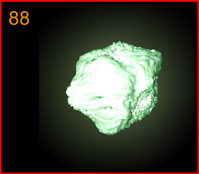Radium
 |
| Name | Radium |
| Symbol | Ra |
| Atomic Number | 88 |
| Atomic Mass | 226.0 atomic mass units |
| Number of Protons | 88 |
| Number of Neutrons | 138 |
| Number of Electrons | 88 |
| Melting Point | 700.0° C |
| Boiling Point | 1737.0° C |
| Density | 5.0 grams per cubic centimeter |
| Normal Phase | Solid |
| Family | Alkaline Earth Metals |
| Period | 7 |
| Cost | $100,000 to $120,000 per gram |
| Origin of Name | From the Latin word radius, meaning ray |
| Date and Place of Discovery | Discovered in 1898 in France Isolated in 1911 in France |
| Discovered by | Discovered by:
Marie Sklodowska Curie and
Pierre Curie Isolated by: Marie Sklodowska Curie and André-Louis Debierne |
| Common Compounds |
|
| Interesting facts |
|
| Common Uses | Previous uses, most of which are no longer in practice, were harmful to the environment and
human health:
|
Photo Courtesy of |
| Radium Atomic Structure | Elements by Name | Elements by Number | Home |